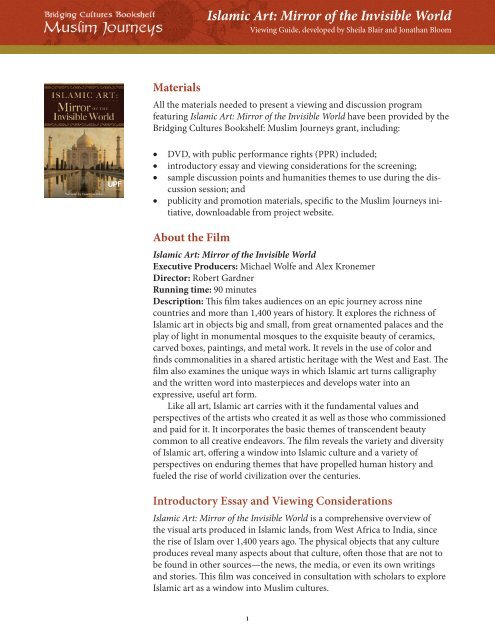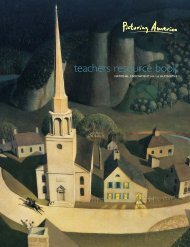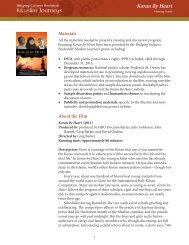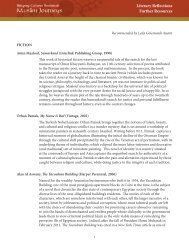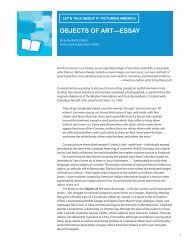Islamic Art: Mirror of the Invisible World - Programming Librarian
Islamic Art: Mirror of the Invisible World - Programming Librarian
Islamic Art: Mirror of the Invisible World - Programming Librarian
You also want an ePaper? Increase the reach of your titles
YUMPU automatically turns print PDFs into web optimized ePapers that Google loves.
<strong>Islamic</strong> <strong>Art</strong>: <strong>Mirror</strong> <strong>of</strong> <strong>the</strong> <strong>Invisible</strong> <strong>World</strong><br />
Viewing Guide, developed by Sheila Blair and Jonathan Bloom<br />
Materials<br />
All <strong>the</strong> materials needed to present a viewing and discussion program<br />
featuring <strong>Islamic</strong> <strong>Art</strong>: <strong>Mirror</strong> <strong>of</strong> <strong>the</strong> <strong>Invisible</strong> <strong>World</strong> have been provided by <strong>the</strong><br />
Bridging Cultures Bookshelf: Muslim Journeys grant, including:<br />
• DVD, with public performance rights (PPR) included;<br />
• introductory essay and viewing considerations for <strong>the</strong> screening;<br />
• sample discussion points and humanities <strong>the</strong>mes to use during <strong>the</strong> discussion<br />
session; and<br />
• publicity and promotion materials, specific to <strong>the</strong> Muslim Journeys initiative,<br />
downloadable from project website.<br />
About <strong>the</strong> Film<br />
<strong>Islamic</strong> <strong>Art</strong>: <strong>Mirror</strong> <strong>of</strong> <strong>the</strong> <strong>Invisible</strong> <strong>World</strong><br />
Executive Producers: Michael Wolfe and Alex Kronemer<br />
Director: Robert Gardner<br />
Running time: 90 minutes<br />
Description: This film takes audiences on an epic journey across nine<br />
countries and more than 1,400 years <strong>of</strong> history. It explores <strong>the</strong> richness <strong>of</strong><br />
<strong>Islamic</strong> art in objects big and small, from great ornamented palaces and <strong>the</strong><br />
play <strong>of</strong> light in monumental mosques to <strong>the</strong> exquisite beauty <strong>of</strong> ceramics,<br />
carved boxes, paintings, and metal work. It revels in <strong>the</strong> use <strong>of</strong> color and<br />
finds commonalities in a shared artistic heritage with <strong>the</strong> West and East. The<br />
film also examines <strong>the</strong> unique ways in which <strong>Islamic</strong> art turns calligraphy<br />
and <strong>the</strong> written word into masterpieces and develops water into an<br />
expressive, useful art form.<br />
Like all art, <strong>Islamic</strong> art carries with it <strong>the</strong> fundamental values and<br />
perspectives <strong>of</strong> <strong>the</strong> artists who created it as well as those who commissioned<br />
and paid for it. It incorporates <strong>the</strong> basic <strong>the</strong>mes <strong>of</strong> transcendent beauty<br />
common to all creative endeavors. The film reveals <strong>the</strong> variety and diversity<br />
<strong>of</strong> <strong>Islamic</strong> art, <strong>of</strong>fering a window into <strong>Islamic</strong> culture and a variety <strong>of</strong><br />
perspectives on enduring <strong>the</strong>mes that have propelled human history and<br />
fueled <strong>the</strong> rise <strong>of</strong> world civilization over <strong>the</strong> centuries.<br />
Introductory Essay and Viewing Considerations<br />
<strong>Islamic</strong> <strong>Art</strong>: <strong>Mirror</strong> <strong>of</strong> <strong>the</strong> <strong>Invisible</strong> <strong>World</strong> is a comprehensive overview <strong>of</strong><br />
<strong>the</strong> visual arts produced in <strong>Islamic</strong> lands, from West Africa to India, since<br />
<strong>the</strong> rise <strong>of</strong> Islam over 1,400 years ago. The physical objects that any culture<br />
produces reveal many aspects about that culture, <strong>of</strong>ten those that are not to<br />
be found in o<strong>the</strong>r sources—<strong>the</strong> news, <strong>the</strong> media, or even its own writings<br />
and stories. This film was conceived in consultation with scholars to explore<br />
<strong>Islamic</strong> art as a window into Muslim cultures.<br />
1
<strong>Islamic</strong> <strong>Art</strong>: <strong>Mirror</strong> <strong>of</strong> <strong>the</strong> <strong>Invisible</strong> <strong>World</strong><br />
Viewing Guide, developed by Sheila Blair and Jonathan Bloom<br />
Gardner Films had previously made <strong>the</strong> three-hour PBS 2001<br />
documentary Islam: Empire <strong>of</strong> Faith that explored <strong>the</strong> first thousand years<br />
<strong>of</strong> <strong>Islamic</strong> history. It had a strong emphasis on culture, especially <strong>the</strong> visual<br />
arts, but this film goes fur<strong>the</strong>r, covering more regions and more artistic<br />
techniques. Ra<strong>the</strong>r than following a chronological scheme through <strong>the</strong><br />
myriad overlapping dynasties that ruled in various regions <strong>of</strong> <strong>the</strong> Muslim<br />
world at different times, this new film is organized <strong>the</strong>matically. It focuses<br />
on five <strong>the</strong>mes—<strong>the</strong> Word, Space, Ornament, Color, and Water—that<br />
can be found in many <strong>of</strong> <strong>the</strong> arts produced in Muslim societies. Many <strong>of</strong><br />
<strong>the</strong>se same <strong>the</strong>mes are characteristic <strong>of</strong> o<strong>the</strong>r art traditions. <strong>Art</strong>ists always<br />
love color, for example, and <strong>the</strong> Chinese and Japanese art shows a love <strong>of</strong><br />
calligraphy, or beautiful writing, similar to that seen in <strong>Islamic</strong> art. But<br />
toge<strong>the</strong>r <strong>the</strong>se five <strong>the</strong>mes exemplify many <strong>of</strong> <strong>the</strong> aspects characteristic <strong>of</strong><br />
<strong>Islamic</strong> art over <strong>the</strong> centuries.<br />
“<strong>Islamic</strong> art” can be a somewhat confusing expression. It encompasses<br />
not only art made specifically for religious purposes (similar to Christian<br />
or Buddhist art), but also secular art made in Muslim-majority societies,<br />
where Islam is <strong>the</strong> dominant, though not <strong>the</strong> only, religion. Therefore a<br />
mosque or a manuscript <strong>of</strong> <strong>the</strong> Qur’an would certainly qualify as <strong>Islamic</strong><br />
art, but so would a ceramic bowl or a rosewater sprinkler made in medieval<br />
Iran. The Great Mosque <strong>of</strong> Cordoba and <strong>the</strong> Alhambra Palace in Granada<br />
are both in Spain where Muslims maintained a significant presence during<br />
<strong>the</strong> Middle Ages. While one is a decidedly religious structure and <strong>the</strong> o<strong>the</strong>r<br />
is largely secular, <strong>the</strong>y are both extraordinary examples <strong>of</strong> <strong>Islamic</strong> art.<br />
We even find, paradoxically, examples <strong>of</strong> “<strong>Islamic</strong> art” made for Jewish or<br />
Christian patrons, such as a group <strong>of</strong> inlaid metalwares with scenes from<br />
<strong>the</strong> New Testament.<br />
This film tries to clarify some <strong>of</strong> <strong>the</strong> common misperceptions about Islam<br />
and its art. For example, many people think that Islam is concentrated in<br />
<strong>the</strong> Arab lands <strong>of</strong> <strong>the</strong> Middle East, but this film shows that <strong>Islamic</strong> art was<br />
produced from West Africa to India (and beyond). Many people believe that<br />
Islam forbids figural imagery, but this film shows that this is not true: while<br />
Muslims disapprove <strong>of</strong> figures in religious art, <strong>the</strong>ir secular art <strong>of</strong>ten depicts<br />
human or animal figures. And while many people believe that violence is<br />
<strong>the</strong> chief characteristic <strong>of</strong> <strong>Islamic</strong> culture, this film shows <strong>the</strong> celebration <strong>of</strong><br />
beauty in <strong>Islamic</strong> civilization throughout its history.<br />
Humanities Themes<br />
• <strong>Islamic</strong> art as a window into <strong>Islamic</strong> culture: The physical objects that any<br />
culture produces reveal many aspects about that culture, <strong>of</strong>ten those that<br />
o<strong>the</strong>r sources—its writings and its traditional stories—may not reveal.<br />
• <strong>Art</strong>ists throughout <strong>the</strong> Muslim world transform everyday objects<br />
into works <strong>of</strong> aes<strong>the</strong>tic enjoyment: Ra<strong>the</strong>r than making monumental<br />
2
<strong>Islamic</strong> <strong>Art</strong>: <strong>Mirror</strong> <strong>of</strong> <strong>the</strong> <strong>Invisible</strong> <strong>World</strong><br />
Viewing Guide, developed by Sheila Blair and Jonathan Bloom<br />
sculptures and paintings to decorate <strong>the</strong> churches and palaces <strong>of</strong> <strong>the</strong><br />
rich and powerful, artists in Muslim societies <strong>of</strong>ten focus <strong>the</strong>ir efforts<br />
on embellishing smaller objects used in daily life, such as carpets, bowls,<br />
pitchers, and trays.<br />
• The <strong>the</strong>mes <strong>of</strong> The Word, Space, Ornament, Color, and Water are present<br />
in many artistic traditions, but are particularly important in <strong>the</strong> arts<br />
<strong>of</strong> <strong>the</strong> <strong>Islamic</strong> lands because <strong>of</strong> <strong>the</strong>ir religious and historical traditions as<br />
well as <strong>the</strong>ir geographical situation.<br />
Sample Discussion Points<br />
1. Why do you think “The Word” is <strong>the</strong> first <strong>of</strong> <strong>the</strong> five <strong>the</strong>mes? Why are<br />
manuscripts <strong>of</strong> <strong>the</strong> Qur’an so beautiful? Why are Qur’anic inscriptions<br />
found so <strong>of</strong>ten on buildings and o<strong>the</strong>r works <strong>of</strong> art?<br />
2. Arabic script reads from right to left. Does this fact affect how you view<br />
<strong>Islamic</strong> art after seeing this film? How might this affect <strong>the</strong> way a viewer<br />
looks at <strong>Islamic</strong> art?<br />
3. What are <strong>the</strong> most common types <strong>of</strong> objects shown in this film? What<br />
materials were <strong>the</strong>y made from? How were <strong>the</strong>y used and in what settings?<br />
How might you explain why this is? How are <strong>the</strong>se works <strong>of</strong> art<br />
different from what you might expect to find in a typical art museum?<br />
4. Some people consider <strong>Islamic</strong> art to be <strong>the</strong> art <strong>of</strong> a faith, while o<strong>the</strong>rs<br />
think <strong>of</strong> it as <strong>the</strong> art made in a particular place at a particular time. What<br />
do you think? What would you consider to be <strong>the</strong> spiritual/religious<br />
aspects and <strong>the</strong>mes in <strong>Islamic</strong> art?<br />
5. Do you find <strong>Islamic</strong> art to be compelling? What draws you to it? Are<br />
<strong>the</strong>re aspects <strong>of</strong> it that you find confusing or unfamiliar? And why?<br />
3


